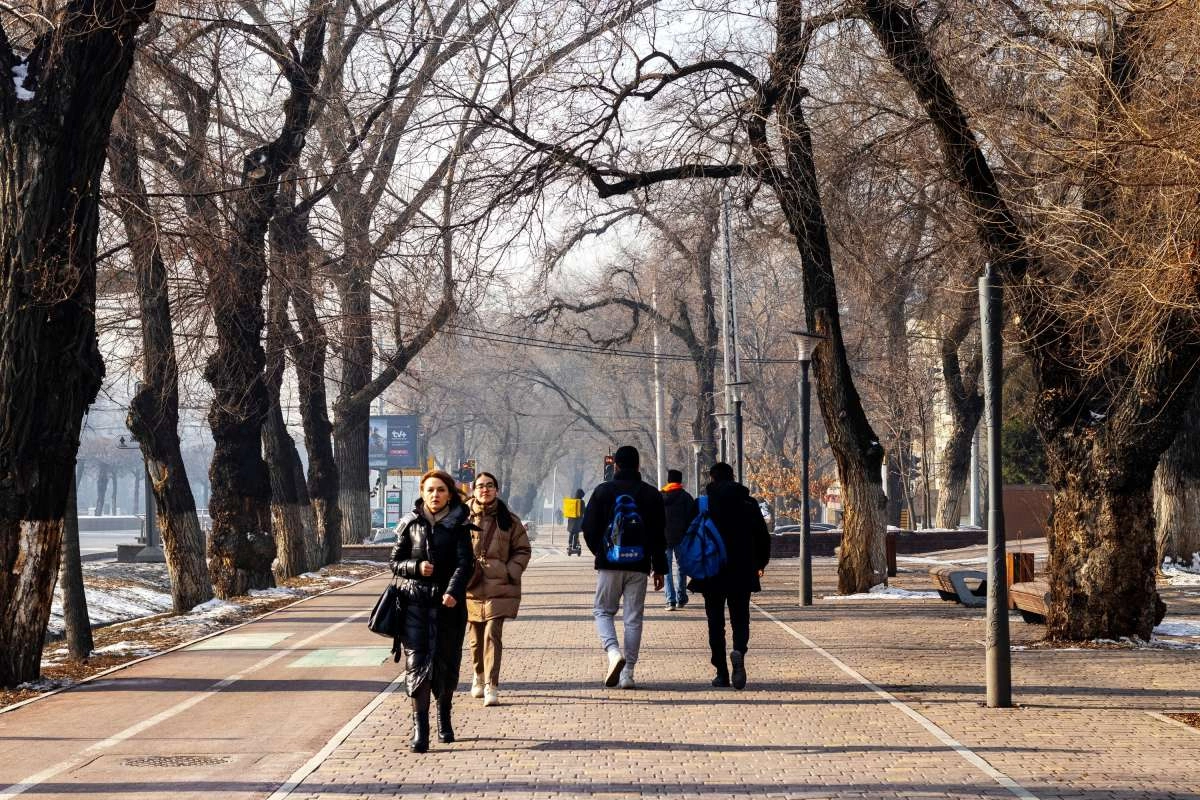
The relationship between Kazakhstan and Russia is complicated, but after Moscow’s invasion of Ukraine, Kazakhs have been reflecting a little more angrily about the way their republic was brutally shaped by Russian power over the past century.
Some claim that Kazakhstan was “invented” by “civilizing” Russians, but they forget the atrocities committed during the days of Soviet rule and the Russian Empire. Image: Minar Aslanova/Shutterstock
Since the beginning of the Russian invasion of Ukraine, the discourse about Russian imperialism and Putin’s desire to reestablish the Soviet Union, or at least to influence its former colonies, has become widely discussed in Russia and criticized in the West. But are these claims as new as the West presents them to be?
In his 1990 essay “Rebuilding Russia,” first published in Komsomolskaya Pravda, the Nobel Peace laureate Aleksandr Solzhenitsyn shared his imperialist views by suggesting that Russia, Ukraine and Belarus should be united into one “Russian Union.” Although he suggested that the other 12 states of the Soviet Union should be set free, he regarded the Central Asian countries as Russia's “underbelly.” In particular, he claimed that Kazakhstan’s “present huge territory was stitched together by the communists in a completely haphazard fashion: wherever migrating herds made a yearly passage would be called Kazakhstan.” This point of view seems to have gained momentum recently, as more claims are made by Russian officials saying that today’s North Kazakhstan needs to be “returned” to Russia and that Kazakhstan’s territory was a “gift” from Russia.
One Russian politician espousing this view is Konstantin Zatulin. In a June 2022 interview with Radio Moskva, apparently threatening Kazakhstan with possible occupation, he said: “There are many towns with a predominantly Russian population that have little to do with what was called Kazakhstan. I’d like Astana not to forget that with friends and partners, we don’t raise territorial matters and don’t argue. With the rest – like, for example, with Ukraine – everything is possible.”
The comment came a week after President of Kazakhstan Kassym-Zhomart Tokayev publicly refused to recognize annexed territories of Ukraine during his visit to Russia for the International Economic Forum in Saint Petersburg.

President Kassym-Jomart Tokayev attends a session of the St. Petersburg International Economic Forum in Saint Petersburg, Russia on June 17, 2022. Image: president.kz
Another of the latest claims by Russian officials against Kazakhstan’s territorial integrity came in a social media post from ex-Russian president Dmitry Medvedev describing Kazakhstan as a manufactured state with former Russian territories and calling resettlement of ethnic Kazakhs to the northern part of the country a “genocide against Russians.” However, the post was quickly taken down, and it was suggested that Medvedev’s account had been hacked and he had never written the post.
In 2020, Vyacheslav Nikonov, chairman of the Committee on Education and Science of the Russian State Duma, claimed on Russian state TV that Northern Kazakhstan was a “gift from Russia” and Kazakhs previously existed only in the south. At the time, it caused outrage from Kazakhstanis, and the Foreign Ministry of Kazakhstan issued an official statement claiming that such comments may worsen the two countries' relationships.
There are even claims that Kazakhstan was “invented” by “civilizing” Russians. This attitude was once common for colonialist countries with Eurocentric beliefs of saving the “savages” from their way of living. It is hard for them to comprehend that Kazakh nomads didn’t need Russians to “save” them. Meanwhile, Russians who believe they brought civilization to Central Asia forget the atrocities committed during the days of Soviet rule and the Russian Empire.[1] These horrors were multi-pronged: arrest and murder of the local intelligentsia, man-made famine, forced resettlements, Russification and nuclear testing. We’ll examine each in turn.
Stalin’s period of dominance in the USSR was maintained by a brutal system of terror and political repression. This was not by any means limited to Central Asia, but Kazakhstan suffered its share. According to Kazakh officials, from 1921 to 1954, approximately 100,000 people were convicted of “political crimes,” and 25,000 people were executed. Among them were prominent figures of Kazakh intelligentsia and active members of the Alash Party, a political group created in the first quarter of the 20th century to fight against Russian Empire colonialism and to revive Kazakh statehood. The long years of repression led to a mass exodus of opposition voices, with the Kazakh diaspora spreading to neighbouring countries — China, Iran, Turkey, and others.
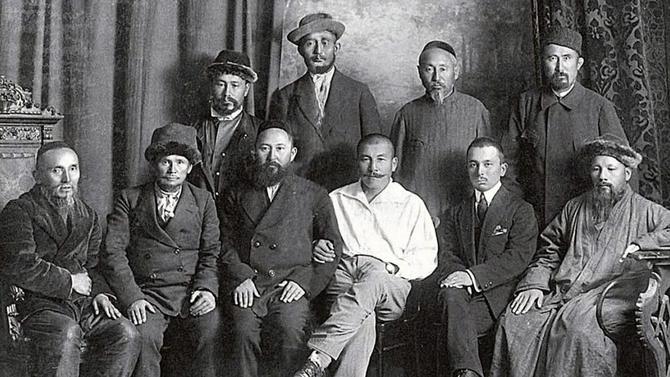
Members of Alash party in Semipalatinsk, 1918. Image: Wikimedia Commons
You probably heard about the Holodomor, a man-made famine that killed around 3 million people in Soviet Ukraine. Tragically it wasn’t limited to Ukraine. From 1930 to 1933, Kazakhstan suffered a lesser-known famine called the Asharshylyk (“great hunger”).
According to historians, this killed around 1.5 million people leading Kazakhs to become a minority in their own republic. The cause of the famine was collectivization; Stalin’s agricultural reforms designed in part to industrialize the Soviet Union to compete with the capitalist West. However, due to the nomadic lifestyle, Stalin’s attempt to “modernize” Kazakhs resulted in more deaths and repressions.
Sarah Cameron, author of “The Hungry Steppe,” explains: “it was also about the struggle to transform nomadic peoples like the Kazakhs from a system of long-distance animal herding to a network of meat packing combines and slaughterhouses that would produce meat for the market.”
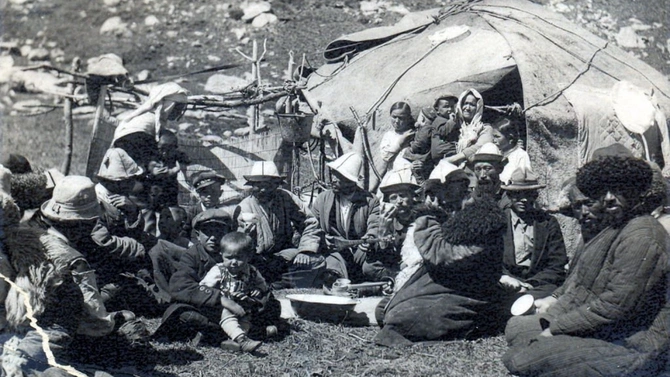
Kazakh nomads. Image: bolashaq.edu.kz
She further explains why there is such a lack of awareness of the Kazakh famine compared to Ukraine’s Holodomor. Kazakhstani officials avoid bringing up the matter to avoid poisoning the political relationship with Russia, in contrast to the situation in Ukraine, where Kyiv openly calls the Holodomor “genocide” and blames Moscow. Also significant are the efforts of the Ukrainian diaspora in the West to spread awareness about Holodomor – while Kazakhstan’s diaspora is smaller and less vocal. Lastly, Cameron believes that because Kazakhs were a nomadic nation, there was a lack of historical documentation – rather than writing the tales of suffering on paper, Kazakhs tended to retell events orally.
During the Stalin period, people from numerous ethnic and religious groups were deported from their Soviet homelands. Many were sent to Kazakhstan. Among them were Germans, Poles, Chechens, Ingush, Kalmyks, Crimean Tatars, Koreans, Finns, Meskhetian Turks, Kurds, Jewish people, and the list goes on. The initial wave of deportations was due to “dekulakization” - ridding areas of “kulaks” (prosperous peasants who were perceived to be incurable capitalists). Later, during World War II, the cited reason for vast overnight forced migrations was generally “collaboration with German fascists.” Many of the deportees died en route, but those that survived and found themselves in Kazakhstan arrived in a republic with space to settle, given the deaths of a third of Kazakhs during the famine years. However, lack of food remained a significant issue during those times.
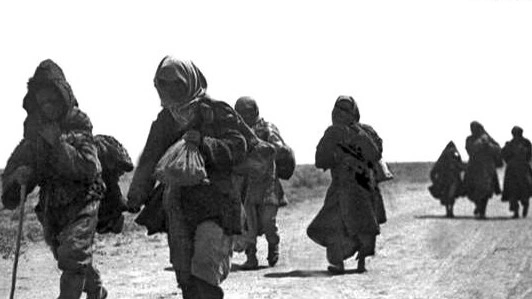
Kazakhs fleeing the famine. Image: Public Domain
All of the above significantly shifted the ethno-demographic balance in Kazakhstan, a process which continued – albeit less horrifically – in the 1950s with Khrushchev's "Virgin Lands” campaign. This saw new settlers coming into the republic to boost the Soviet Union’s agriculture, leaving Kazakh farmers displaced yet again. Kazakhstan ended up a multiethnic republic in which Kazakhs were a minority.
Although the idea of the Soviet Union officially was to create a Soviet nation, one where ethnic background didn’t matter, the reality was the Russian language was predominantly used. That was especially true in Kazakhstan, where – as we’ve seen above - Kazakhs had become a minority, and many Russians had arrived to build new towns. In order to succeed, it was necessary to speak Russian, which was the medium for all the best educational institutions. For years this created a stigma towards Kazakh speakers as uneducated people. Even today, more people still speak Russian rather than Kazakh. Since the beginning of the war in Ukraine, however, many people in Kazakhstan have started showing interest in learning and speaking Kazakh as a response to Russian imperialism.
Early attempts to create a “Soviet nation” was not limited to Russifying minorities. It also prohibited them from learning deeply about their history. Any attempt to do so was flagged as nationalism, for which an individual could be either executed or sent to a gulag (prison camp). This was meant to erase the feeling of belonging to one's ethnicity: remembering one’s roots and celebrating one’s ethnic culture and traditions was seen as being against the USSR’s "one nation" policy.
In 1949, four years after the United States dropped bombs on Hiroshima and Nagasaki, the Soviet Union’s secret “Polygon” nuclear testing site in Semipalatinsk (now Semey) conducted its first atomic bombing. It was the first of 456 tests conducted over 40 years. In her article “Kazakhstan’s Nuclear Nightmare,” Joanna Lillis calculates that the total energy released by the bombs detonated at Semipalatinsk was “2,500 times greater than the bomb dropped on Hiroshima in 1945.”
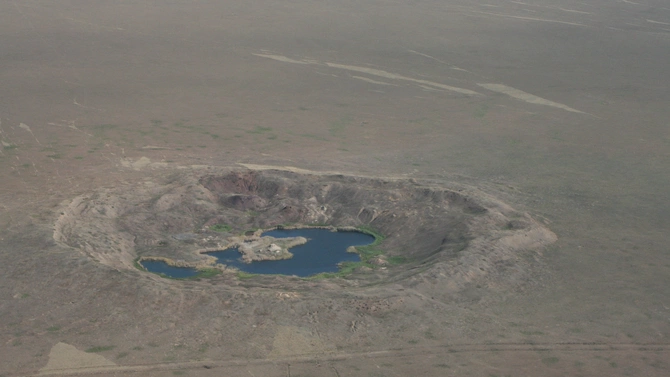
The Semipalatinsk Test Site, known as "The Polygon," was a nuclear test site operated by the Soviet Union. Image: CTBTO/Flikr
It’s estimated that around 1.5 million people living near the Polygon were exposed to radioactive fallout. Kazakhstan’s government issued a moratorium on testing in August 1991, a few months before the dissolution of the USSR. The Polygon has closed, but some people continue to suffer from the consequences of the Cold War.
Photographer Phil Hatcher-Moore’s “Nuclear Ghosts” project has documented today’s reality for the region’s residents. Around 100,000 people still live in an area that has been contaminated since Soviet days. Children are still born with health defects, and adults are diagnosed with unusual cancers and other diseases and disorders. Evidence suggests that the effects of radiation can be passed down for as many as five generations.
Unsurprisingly, Russia, as a successor of the USSR, takes no responsibility for its nuclear testing legacy in Kazakhstan, its former colony. However, the most discouraging thing is that Kazakhstan’s government is neglecting this humanitarian issue by not putting any signs or fences around the 7,065-square-mile territory that even now remains radioactive.
Of course, Russia is not the only post-colonialist country with imperialist sins in its history. France, Britain, Spain, Germany, and Belgium —to name just a few—have plenty to be ashamed of. However, the difference between Western colonialists and Russia is that the latter not only doesn’t pay reparations or issue apologies to those affected by its imperialism. It also doesn’t even acknowledge the horrors caused.
How can we expect the oppressor to acknowledge and apologize for what they’ve done when Kazakhstan’s government shies away from openly discussing the dark pages of its history and whitewashes the truth to avoid offending its northern neighbour?
As long as Kazakhstan continues to remain subordinate to Russia, we will hear threats toward Kazakhstan’s sovereignty and territorial integrity. Only time will tell what future awaits Kazakhstan as Russia continues to demonstrate its desire to revive the fallen empire.
[1] Russian/Soviet rule did bring free healthcare and mandatory education (notably through the Likbez program) but that doesn’t justify or lessen the crimes committed by the regime.
Share on social media